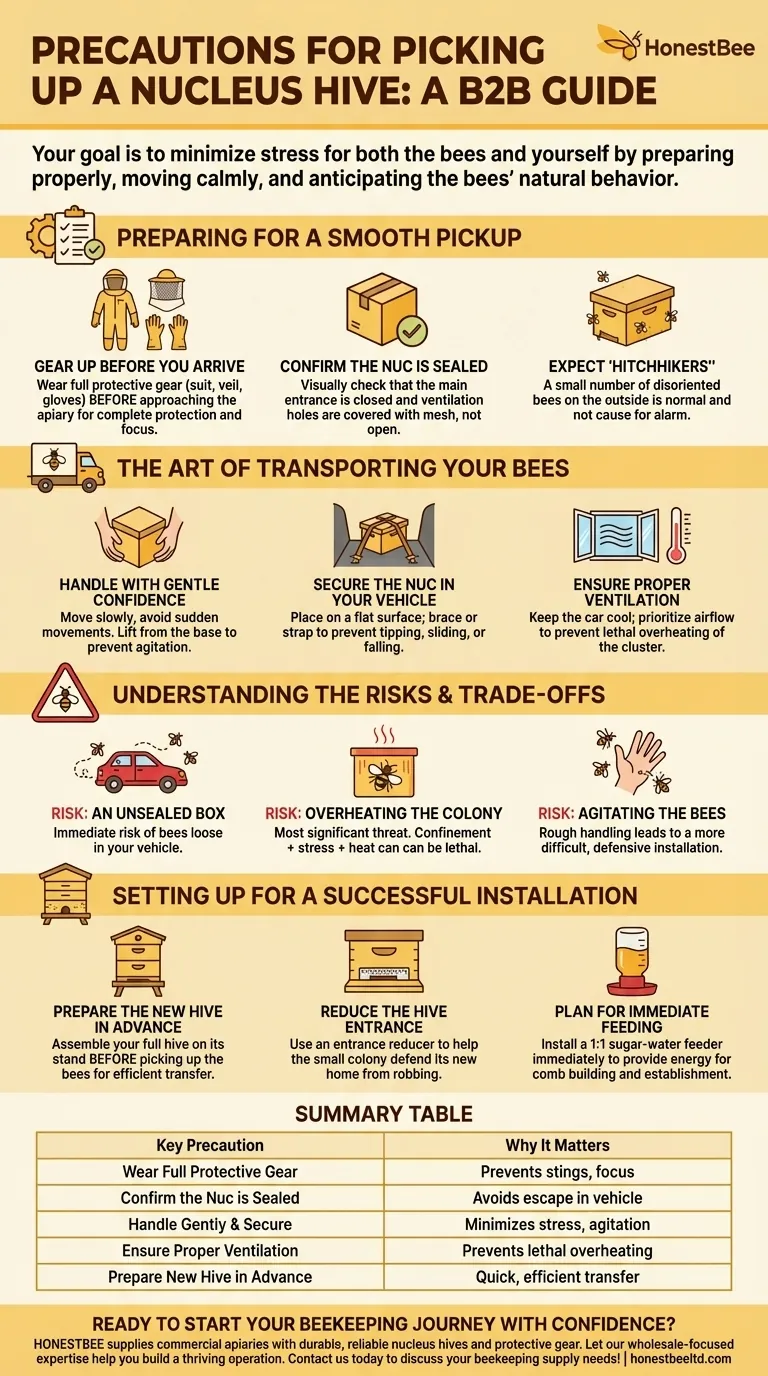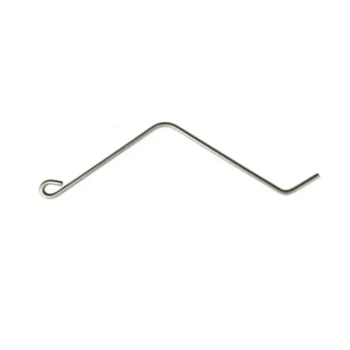When picking up a nucleus hive, your most important precautions are to wear full protective gear, confirm the box is sealed shut, and handle it gently to minimize stress on the colony. Be prepared for a few "hitchhiker" bees on the outside of the box; this is normal and they are not typically aggressive.
Transporting a new colony is less about strength and more about strategy. Your goal is to minimize stress for both the bees and yourself by preparing properly, moving calmly, and anticipating the bees' natural behavior.

Preparing for a Smooth Pickup
The key to a low-stress experience is having everything ready before you arrive. A few minutes of preparation prevents fumbling and anxiety when you have a box of live bees in your possession.
Gear Up Before You Arrive
Always put on your full protective gear—bee suit, veil, and gloves—before you get out of your vehicle at the apiary. This ensures you are protected from the start and can focus completely on the task at hand.
Confirm the Nuc is Sealed
Your bee supplier will have sealed the nuc for transport. However, you should do a quick visual check to confirm the main entrance is closed and any ventilation holes are covered with screen mesh, not open.
Expect 'Hitchhikers'
It is nearly impossible to get every single foraging bee into the nuc box when it's closed up. You will likely see a small number of bees on the outside. These bees are simply disoriented and are not a cause for alarm.
The Art of Transporting Your Bees
Once you have the nucleus hive, your primary job is to be a careful chauffeur. The goal is a calm, uneventful ride home for your new colony.
Handle With Gentle Confidence
Move slowly and deliberately. Avoid any sudden jolts, drops, or jarring motions, as this agitation can make the bees defensive and stressed. Lift and carry the box from its base.
Secure the Nuc in Your Vehicle
A tipped-over nucleus hive in a vehicle is a worst-case scenario. Place the box on the floor or a flat surface where it cannot slide or fall over. You can use straps or place other objects around it to brace it securely.
Ensure Proper Ventilation
A dense cluster of bees generates a significant amount of heat. On a warm day, a poorly ventilated nuc can overheat, which can kill the brood or even the entire colony. Keep the car cool and never leave the nuc in a parked, hot vehicle.
Understanding the Risks and Trade-offs
Knowing the potential pitfalls is key to avoiding them. Transporting bees is safe and straightforward when you respect the following risks.
Risk: An Unsealed Box
The most immediate risk is bees getting loose inside your car. This is why you must perform a quick visual check to ensure all entrances are securely closed before placing the nuc in your vehicle.
Risk: Overheating the Colony
This is the most significant threat to the bees' health during transport. The combination of confinement, stress, and their own body heat can be lethal. Prioritizing airflow and a cool environment is non-negotiable.
Risk: Agitating the Bees
Rough handling doesn't just make the ride stressful; it creates a more difficult installation. Agitated, defensive bees are much harder to transfer into their new hive. A calm transport leads to a calm transfer.
Setting Up for a Successful Installation
The moment you arrive home, the focus shifts to giving the colony a safe and comfortable start.
Prepare the New Hive in Advance
Your new, full-sized hive—including the bottom board, hive body, frames, and cover—should be completely assembled and placed on its stand before you return with the bees. This makes the transfer process efficient and minimizes the time the bees are disturbed.
Reduce the Hive Entrance
A small, new colony is vulnerable to being robbed by stronger hives in the area. Use an entrance reducer to make the opening smaller, allowing the colony to more easily defend its new home.
Plan for Immediate Feeding
The bees have been confined and their foraging has been interrupted. Installing a feeder with a 1:1 sugar-water solution gives them an immediate and essential source of energy to begin building comb and establishing themselves. Ensure the feeder is properly sealed to prevent leaks that can drown bees.
Key Precautions for Your Goal
If you are a brand-new beekeeper: Prioritize wearing full protective gear without exception and have your new hive completely assembled before you pick up the bees.
If you are transporting over a long distance: Focus on securing the nuc against movement and ensuring constant, adequate ventilation to prevent the colony from overheating.
If your primary concern is avoiding stings: Move slowly and deliberately at all times, put your gear on before approaching the bees, and remember that your calm handling directly results in calmer bees.
Proper preparation transforms the challenge of moving bees into a calm and rewarding first step in your beekeeping journey.
Summary Table:
| Key Precaution | Why It Matters |
|---|---|
| Wear Full Protective Gear | Prevents stings and allows you to focus on handling the bees calmly. |
| Confirm the Nuc is Sealed | Avoids bees escaping inside your vehicle during transport. |
| Handle Gently & Secure in Vehicle | Minimizes stress and agitation, leading to a calmer colony. |
| Ensure Proper Ventilation | Prevents overheating, which can be lethal to the confined bees. |
| Prepare New Hive in Advance | Allows for a quick, efficient transfer and reduces disturbance. |
Ready to Start Your Beekeeping Journey with Confidence?
HONESTBEE supplies commercial apiaries and beekeeping equipment distributors with the durable, reliable nucleus hives and protective gear you need for a successful start. Let our wholesale-focused expertise help you build a thriving operation.
Contact us today to discuss your beekeeping supply needs!
Visual Guide

Related Products
- Versatile Ratchet Hive Strap with S-Hooks for Secure Fastening
- Endless Loop Ratchet Hive Strap
- Professional Galvanized Hive Strap with Secure Locking Buckle for Beekeeping
- Heavy Duty Ratchet Hive Strap
- Multi-Functional Rotary Hive Entrance Disc for Beekeeping
People Also Ask
- What should you consider when positioning the hive in the vehicle? Ensure a Safe & Stress-Free Move for Your Colony
- How do you loosen a ratchet strap? Master the 180-Degree Release for Easy Unloading
- Why should a tie-down strap be used to secure a hive? Protect Your Colony from Tipping and Damage
- How should you secure the bees before moving them? A Guide to Safe, Stress-Free Hive Transport
- What are the basic components of beekeeping equipment? Build a Thriving Hive from the Start



















